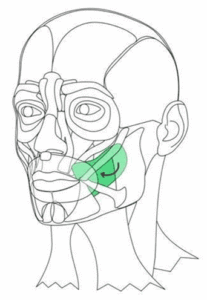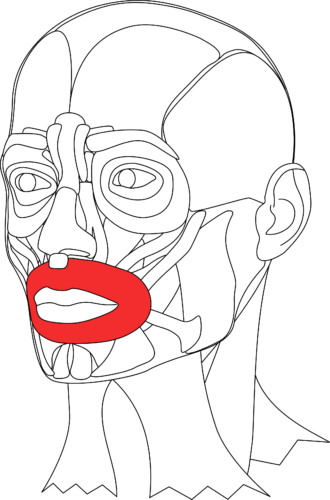Eating and drinking 
There are three important muscles involved in eating and drinking. Problems arise when the muscles are weak and floppy (flaccid stage), and also when the muscles become, thick, tight and shortened (synkinetic stage). People will experience varying degrees of difficulty with eating and drinking.
Symptoms may be mild and recover quickly or more obvious and persist for some months. For example, pouching of food in the cheek; loss of food, fluid and saliva from the corner of the mouth; coughing or choking during or after eating and pain or neck cramping on the affected side when swallowing.
Causes
There are three muscles which help us to eat, drink and swallow efficiently. The buccinator muscle, the orbicularis oris muscle, and the digastric and stylohyoid muscles.

The buccinator muscle sits right on the inside of the cheek next to the teeth. It presses the cheek against the teeth which helps keep food between our teeth for chewing. During the flaccid stage of recovery, when the affected buccinator muscle is weak and floppy, it is no longer able to keep the food between the teeth for chewing. Secondly, it is no longer able to keep the food central in our mouth when we prepare food for swallowing. The result is loss of food into the hollow of the cheek. This is referred to as pouching, as food residue after eating accumulates in the affected cheek.
During the synkinetic stage of recovery, the buccinator muscle can become very tight. This causes food to become trapped inside the cheek which is difficult to remove. It is a symptom which can go undetected by the person with facial palsy which is one reason why dental hygiene is so important.
Sealing the lips

The orbicularis oris or lip muscle makes the lips pucker, whistle, press together and roll inwards. When we eat, drink, chew and swallow the orbicularis oris should press the lips together to make a seal. This seal prevents food, fluid and saliva from leaking out of our mouths. The sealed lips also create pressure inside our mouth necessary for swallowing. It is difficult to swallow without a lip seal. When the orbicularis oris is weak and floppy (flaccid stage), or when it is short and tight (synkinetic stage), it can be difficult to form a complete seal. This causes loss of food, fluid or saliva from the corner of the mouth. This is distressing and embarrassing and people with facial palsy often avoid eating and drinking in public and may prefer to eat alone.
Swallowing
The posterior head of digastric and stylohyoid muscles have an important role to play in the swallowing process. This can be seen as an upward and outward movement when we swallow. If you place your fingers gently over your Adam’s apple and swallow, you will be able to feel this movement. As men have a larger Adam’s apple it is easier to see this happening.
The muscles also lift the base of the tongue upwards and backwards when we swallow. We do this without thinking about it. If you consciously think about swallowing you will notice how the back of the tongue humps up and pushes against the back of the throat. In doing so the tongue acts as a plunger pushing food and fluids into the top of the swallowing tube.
During the flaccid stage these muscles may become weak resulting in the following symptoms:
- Choking during or after meals.
- Coughing during or after swallowing especially on liquids or mixed consistencies, for example, cereal floating in milk.
- A sensation of food getting stuck because the plunging action of the tongue may not be working efficiently.
During the synkinetic stage of recovery these muscles may become tight resulting in the following symptoms:
- Pain on swallowing
- Cramping in the neck when swallowing
What can help?
- Always sit upright in a well-supported chair during mealtimes. This will aid digestion and will allow the lungs to expand more easily. Secondly, should you find you are coughing or choking, you will be more able to clear any inhaled food/fluid in this position.
- Avoid distractions when eating/drinking, as you will need to concentrate. It might help to turn off the TV if you have this on during mealtimes. Secondly, limit the amount of talking during mealtimes, as you need to focus more on chewing and preparing your food/drinks to avoid coughing/choking and food/fluids leaking from the corner of your mouth.
- Avoid tipping your head back when you drink from a bottle or cup. Tipping the head backwards opens up the airway and increases the risk of drinks going down the wrong way. Try drinking from a straw instead although sealing your lips around a straw may be problematic. Alternatively, you could try drinking from a kapicup which allows you to tip the cup rather than tipping your head back. These are produced by Kapitex and can be ordered online or over the phone.
- If you do experience frequent coughing or choking during or after meals, you can ask your GP to refer you to a speech and language therapist who can assess your swallowing and make specific recommendations.
- Eat and drink more slowly and avoid rushing. Weak muscles will take longer to get to where they need to be, so allow more time when eating or drinking.
- Loss/leaking of fluid from the corner of the mouth can be reduced by drinking from a thin-lipped cup or mug with a turned-down rim.
- Smaller mouthfuls are easier to control and make it less likely for food or fluid to leak from the corner of your mouth.
- Avoid chewy foods, for example, stringy meats and leafy vegetables, as these tend to fall into the cheek.
- Avoid dry crumbly food, for example, dry toast or dry sponge cakes. These textures are more easily inhaled and more likely to cause coughing. You can always add extra butter or fillings to make them easier to swallow. Other foods which may be more difficult to manage are stringy foods and those with shells, husks or seeds, for example, peas; sweetcorn; tomatoes; baked beans.
- Adding extra sauces, butter, gravy may make swallowing easier.
- Placing the food slightly further back in your mouth may stop leakage of food from the corner of the mouth.
- You can learn which foods/drinks are easier to control by keeping a brief food diary. Make a note of things which make you cough/choke and avoid them. Make a note of foods which cause less pouching and are easier to control. A soft, moist, easy chew diet may be the best option but make sure your diet is balanced.
Finally, a dry mouth can make eating and preparing food for swallowing more difficult. Saliva is important for: moistening food; binding food into a cohesive ball ready for swallowing (a bolus); moistening the mouth so the lips, tongue and cheek can glide easily over the teeth; spreading particles of food over the tongue to aid tasting.
Top tip: always brush your teeth after eating to remove any food debris that may have collected inside the affected cheek.
Read more
Photo by Artem Beliaikin on Unsplash
